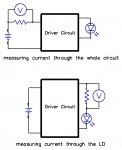Re: 6x Blu-ray SLEDS GB! THEY ARE GOING FAST!
danq said:
Igor, do you have any ideas on why that would be the case? Especially if care is taken to capture the whole beam in the power meter's sensor... I don't see why that should be not repeatable ??? I'm not doubting your opinion on this, just confused about why it would be that way.
:-?
I thought so too, Dan.. But i don't trust the no-lens measurements anymore.
There are two reasons i say that:
- Theoretically, from the point where the entire output is within the active area of the thermopile, the reading should not change with distance. But if you bring the diode closer, the reading climbs, even tho the same amount of light is hitting the active area of the thermopile. It's hitting a smaller area with a higher energy density, but for a thermopile, that shouldn't matter. This could be from the IR - the thermopile measuring heat coming from the diode, so it will show more, and how much more will depend on the distance - the closer, the more FIR you will measure..
- If the diode is in an AixiZ module simply without a lens, the fast axis of the output diverges so fast, that it hits the inner walls of the module - the threads where the lens-nut is. When you use a lens, the ideal lens would be deeper in the module, than at the point where light hits the walls of the module. This way it can collect all the output and get it out. But without a lens, some light will hit the module walls. This will reduce the output.
Another possibility is, that the reflections of the light from the walls of the module cause the measurement to vary with distance, even tho the main light cone covers the active area of the thermopile from the start.
But the main reason i say that is, that every time someone measures the difference between a no-lens and a yes-lens output, they get a different percentage of difference. A part of this will inevitably come from the fact, that short wl's pass acrylic materials harder, than longer wl's, but that's usually a small percentage.
It is repeatable, if you always do it the same way, but it doesn't seem to be too repeatable between different testers.
Ideally, the no-lens measurement should be done without a module, with the diode so close, that the fast axis is within the active area, and with a FIR filter in between, with a known transmittance for 405nm. At least that's how i imagine it. I don't really know how diode manufacturers measure the raw output. It could also be a very high NA lens of known 405nm transmittance.






